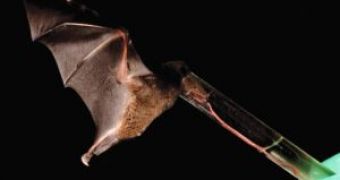Gene Simmons could be jealous.
Researchers discovered last year in the mountain cloud forests of Ecuador a rare bat, the tube-lipped nectar bat (Anoura fistulata) which despite its mouse size, its tongue 8.5 cm long is 1.5 times longer than its body and more than double the tongue-length of similar nectar bats.
The bat is related to the infamous vampire bat.
Compared with its body, this tongue is second only to the chameleon in terms of vertebrates, and it is the longest of all the mammals.
Nectar bats' tongues have tiny hairs on the end, which they use to mop up nectar and pollen from within flowers. The plants gain from this relationship by depositing pollen on the bat's head, which it spreads from flower to flower.
"It's like a cat being able to lap milk from two feet away," Said Nathan Muchhala of the University of Miami, Florida, US, who discovered the species.
Despite its exceptionally long tongue, the tube-lipped nectar bat has a varied diet that includes also insects.
This arrangement is possible due to its short jaw; the base of the tongue is in the bat's rib cage.
The bat, which stows its lengthy tongue in its rib cage, pollinates a plant with tubes of the same length.
"I had all sorts of theories, such as perhaps the tongue folded up inside, or coiled, or maybe its lower lip was critical somehow. It turned out that the tongue extends down into the bat's chest, and its base is between the heart and sternum. When extended, it stretches by up to three times its stored length," Nathan added.
Muchhala measured the bats' tongues by training them to drink sugared water from a tube, which was approximately the diameter of a drinking straw.
Centropogon nigricans with its 8-9 cm-long corollas, is pollinated exclusively by this bat.
"Muchhala suggests the extreme length of the bat's tongue co-evolved with the long flowers of the plant.
"The straws resemble a flower from the region, called centropogon nigricans, which has a funnel-like neck called a corolla, at the base of which is its nectar. This flower is unique because it relies exclusively on fistulata to pollinate it. Most plants in the region have evolved so all nectar bats can feed from them, but this flower's neck is too long for other "bats to reach down with their tongues," said Muchhala.
"Such a close co-evolutionary relationship is rare. It occurs in other species - some plants have evolved so that only hummingbirds can feed from them - but this is the first known example of a flower pollinated by only one species of bat. The flower gains an advantage over other species of plant in the region because it does not have to compete with them to attract the nectar bats.
"The finding is also an example of convergent evolution, where two unrelated organisms independently evolve similar traits as they adapt to similar environments. Other animals such as scaly anteaters have evolved similarly long tongues, which they use to feed," he added.
The tongue of scaly ant-eaters (from Africa and Southeast Asia) also attach to the rib cage and is so long because the animals bore ant and termite nests to stick insects in order to swallow them.
Photo credit: Nathan Muchhala.

 14 DAY TRIAL //
14 DAY TRIAL // 
